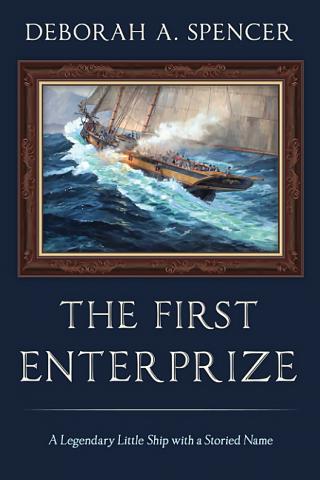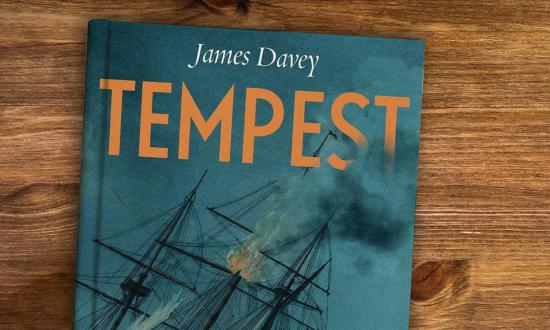The First Enterprize: A Legendary Little Ship with a Storied Name
Deborah A. Spencer. Colorado Springs, CO: Tactical 16 Publishing, 2022. 355 pp. Notes. Images. Biblio. Index. $35.99.
Reviewed by Andrew G. Wilson
Typically, books about the U.S. Navy focus on the service’s great leaders, battles, and its use in defense and national strategic contexts, along with its various platforms and associated technologies and how they have evolved over time. In The First Enterprize, Deborah Spencer provides the reader the story of one of the Navy’s foundational platforms—both as a weapon of war and as a school of leadership—and does so successfully. In just under 400 pages, Spencer traces the brilliant career of a little ship that not only served the nation in multiple conflicts, but also bolstered the careers of several American naval heroes and is the namesake of a line of illustrious vessels that have served the nation on the high seas right up to today’s Enterprise (CVN-80), currently under construction in Newport News, Virginia.
Ordered by the Navy’s first Secretary, Benjamin Stoddert, and launched in 1799 from Maryland’s Eastern Shore, the schooner (later brig) that would become the USS Enterprize was meant to protect U.S. interests against the French during the Quasi-War (1798–1800). With a career spanning from 1799 to July 1823, when she ran aground on the Caribbean island of Little Curaçao (Klein Curaçao) off the coast of Venezuela, the Enterprize provided a leadership development platform for future Navy leaders and successfully completed vital communication, commerce protection, antipiracy, and show-the-flag (presence) missions. She also served as a superb warship in most of the nation’s early naval conflicts. Spencer relates this vessel’s extraordinary story with a clear appreciation for both the ship and her crews, in-depth research, and a text written with verve. To place the story of the Enterprize in its full context, Spencer draws widely from both secondary literature and contemporary documentation. While the storyline in many ways reads like the ship’s logbook in many respects comes across more like an informative, classic Hornblower novel.
In representing the young United States abroad, the small schooner Enterprize played a significant and near omnipresent role in the Navy’s deployment schedule. Following the Quasi-War, the Enterprize went on to participate in the Barbary Wars and the War of 1812, continuously showing the flag, developing service experience and leadership (Spencer refers to her as “the Enterprize command school”), and ensuring U.S. interests were known and protected beyond the nation’s shores.
Among the reasons the vessel developed such a fine reputation, and an oversized impact, was because of the leaders who served as her captains in the Navy’s formative period. The Enterprize was at various times led by such figures as Isaac Hull, Stephen Decatur Jr., James Lawrence, and David Porter, to name just a few. Such men would—in time—assist in creating a fearsome reputation for the emerging fighting force that was the U.S. Navy. The small Enterprize was a first in other ways as well: She was the first U.S. naval vessel to visit Malta and Syracuse and to enter the Adriatic Sea, including a major yard visit and rebuild at the famous Arsenal of Venice.
In the final assessment, the schooner/brig Enterprize proved the value of small, fast, well-armed ships-of-war in both protecting and advancing the cause and interests of the young republic. With the ability to evade larger hostile ships in narrow or shallow waters, or track similar vessels engaged in smuggling or privateering by matching or negating their speed and shallow draft benefits, vessels such as the Enterprize routinely demonstrated their capability and operational benefits. In short, like her more famous contemporaries, the frigates Constitution and Essex, the Enterprize deserves to have her story told, and Spencer does it so well. As she makes abundantly clear, the tale of the Enterprize is much more than the story of her famous duel with the British brig HMS Boxer during the War of 1812.
The First Enterprize is an excellent tale of a “ship with a storied name.” Well written and laden with detail and historical background on early U.S. Navy people, patrols, and engagements—both the exciting and the mundane—the book delivers on describing the importance of the early republic’s second-tier naval vessels during peace and war, a message that should still ring true today. Spencer brings to life the speed, grace, power, lethality, and lives behind a successful 19th-century vessel of war, as well as many of the critical details underpinning the efficient employment of such vessels. For the casual reader or professional historian looking for a detailed account of early U.S. Navy history from the small-ship perspective, The First Enterprize delivers stem to stern.
Mr. Wilson is a graduate of the U.S. Naval War College and an operational representative with the Department of the Navy.
Thundering Courage: George Armstrong Custer, the Union Cavalry Boy Generals, and Justified Defiance at Gettysburg
Captain Terry C. Pierce, U.S. Navy (Retired). Stanwood, WA: Heart Ally Books, 2023. 652 pp. Illus. Appx. $35.95.
Reviewed by Rear Admiral Paul Becker, USN (Retired)
When is disobeying a direct order justified, or is it never justified? This is a moral and ethical dilemma for military leaders that author Terry Pierce examines throughout his second historical novel, centered around Major General George Custer and the most decisive battle ever fought on U.S. soil. (See, “Anchors Aweigh . . . at Gettysburg,” August 2021, pp. 46-53.) Pierce’s first novel from 2021, Without Warning: The Saga of Gettysburg, a Reluctant Union Hero, and the Men He Inspired, focused on Major General George Meade and included the theme: “Why it’s critical to follow orders.” His latest book is an excellent complement in both action and moral relevance. In both books, Pierce uses a writing technique called “deep point of view,” which enables readers, scene by scene and chapter by chapter, to meld their minds with the main character’s psyche.
All events and individuals in Thundering Courage are factual and paired with timestamps and illustrated maps to ensure a smooth flow of information. All characters in the story were participants in the battle. Custer is the centerpiece, but much attention is devoted to senior leaders such as Brigadier Generals Judson Kilpatrick (nicknamed “Kill Cavalry” for his poor understanding of operational art and disregard for the lives of his soldiers), Elon Farnsworth, David Gregg, and William Miller. Each of those protagonists wrestles with “justified defiance” and provides his own leadership case study through his course of action.
A former commanding officer himself, Pierce has a deep understanding of command and control, commander’s intent, decentralized execution, and discipline in combat. He uses realistic, gripping battlefield dialog to depict Custer’s tactical actions and occasional disdain and disregard for his chain of command’s operational guidance and orders a few weeks prior to and during Gettysburg.
“Custer’s luck” somehow kept him alive against all odds during unshielded, unauthorized cavalry charges, during which he always rode in front. “Promotion or a coffin!” shouts Custer, two weeks prior to Gettysburg at the Battle of Aldie, disobeying an order while leading a charge. In addition to local admonishment, Custer’s daring actions gained the attention of General George Meade, who soon promoted the 23-year-old recent West Point grad. Custer was first in his class to make general and was given command of the Michigan Wolverine Cavalry Brigade because of his inspirational audacity and ability to lead troops. Pierce brilliantly reveals the flaws in Custer’s flamboyant yet tempestuous nature, which would ultimately lead to his demise 13 years later.
General Custer holds a unique place in U.S. military history. At one time, he was considered an unimpeachable national hero. Certainly his exploits leading up to Gettysburg and his anchoring of Meade’s northern flank by leading the ferocious cavalry charges of his Michigan “Wolverines” against Confederate General J. E. B. Stuart’s “Invincibles” justified that reputation. Custer had his horse shot out from under him during a pivotal day of combat but still managed to repulse Stuart’s charge, buy time for reinforcements, and prevent Rebels from reaching the rear of Meade’s army. Decades later, however, it became harder for Americans to accept Custer’s tragic hero story following the 1876 Battle of Little Bighorn because of growing national empathy for Native Americans. Nowadays, Custer has been depicted as the opposite of heroic (reference in a prominent biography to him as a “deplorable soldier” and most recently via pop culture in the movie Night at the Museum 2 as simply vain and ignorant).
Not only is Pierce’s fast-paced novel entertaining, but it also is replete with lessons on dedication to duty, the difference between the extremes of the virtue of courage, from heroism to recklessness, planning, teamwork, flexibility, unit loyalty, and making sense of ambiguous indicators in the absence of intelligence.
Add this to your reading list if you are a fan of the Civil War and/or military leadership. Next time you are at Gettysburg, don’t just travel the route of Pickett’s Charge or climb Little Round Top. Visit the fields and hills that were the centerpieces for Custer’s unquestionable daring, courageous cavalry charges, and successes that helped secure Union victory that historic day.
ADM Becker served as Director of Intelligence on the Joint Chiefs of Staff, the U.S. Pacific Command, the International Security Assistance Force in Afghanistan, and Naval Forces Central Command. In 2016, the Naval Intelligence Community established the “Teamwork, Tone, Tenacity” Leadership Award in his honor upon his retirement.








